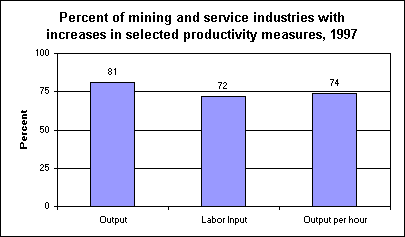An official website of the United States government
 United States Department of Labor
United States Department of Labor
In 1997, output per hour increased in 74 percent of service and mining industries as measured at the 3-digit level of the Standard Industrial Classification (SIC). Output, which is the production of goods and services, rose in 81 percent of the 3-digit industries, while hours of labor input rose in 72 percent.

[Chart data—TXT]
Productivity increased in every measured mining industry except one in 1997. The sole decline in output per hour was recorded in oil and gas extraction. Productivity gains were reported in the three transportation industries for which 1997 data are available: the U. S. postal service; trucking, except local; and air transportation. Among communications industries, most showed increases in productivity; the major exception was radio and TV broadcasting, in which productivity fell. Both of the utilities industries measured by BLS posted gains in productivity in 1997.
Of the 29 published 3-digit industries in retail trade, 20 recorded productivity increases in 1997. Gains in output per hour were posted in 1997 in seven of the nine 3-digit SIC industries in finance and services for which BLS publishes data. Currently, BLS measures labor productivity for one industry in the wholesale trade sector: scrap and waste materials. That industry experienced a rise in productivity 1997.
The productivity data here are a product of the Industry Productivity program. Data are subject to revision. These measures describe the relationship between output and the labor time involved in its production. They show the changes from period to period in the amount of goods and services produced per hour. The reader should note that the year-to-year movements in productivity measures may be somewhat erratic, particularly in the smaller industries. Find more information in " Productivity By Industry: Service Sector and Mining, 1997," news release USDL 99-119.
Bureau of Labor Statistics, U.S. Department of Labor, The Economics Daily, Productivity rose in most mining and service industries in 1997 at https://www.bls.gov/opub/ted/1999/may/wk1/art03.htm (visited January 21, 2026).

